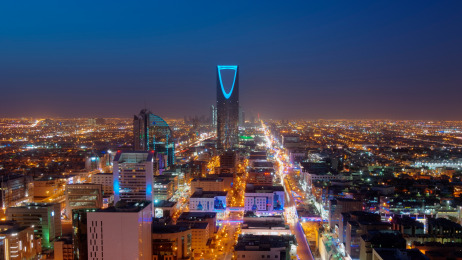
Kamil Tatol
-
Feb 01, 2023
-
3 min read
- 01 . What is Vision 2030?
- 02 . How does Vision of 2030 work?
- 03 . Major topics of Saudi Vision 2030
- 04 . What is the role of digital transformation in Vision 2030?
- 05 . What are the main domains of digital transformation in Vision 2030?
- 06 . What is the future of Digital Transformation in Vision 2030?
What is Vision 2030?
Vision 2030 is a long-term growth program created by Saudi Arabia's government to reduce the country's dependence on oil and develop a more diversified economy. It incorporates endeavours in areas such as infrastructure, education, and tourism, aiming to increase the country's GDP and improve the standard of living for its citizens. The strategy also includes ambitious goals for developing renewable energy and constructing new cities and economic zones. One of the most important branches of this program is Digital transformation, which plays a crucial role in this plan.
How does Vision of 2030 work?
Vision 2030 works through several initiatives and projects conducted by the Saudi Arabian General Investment Authority (SAGIA) and the Public Investment Fund (PIF).
One key initiative is the development of new economic cities and zones, such as the King Abdullah Economic City and the Jeddah Economic City, designed to attract foreign investment and diversify the economy.
Another initiative is the National Transformation Program (NTP), which focuses on specific sectors such as healthcare, education, and transportation, aiming to improve citizens' living standards and increase the country's international competitiveness.
The government is also investing in renewable power and sustainable infrastructure projects, such as developing a solar power industry and constructing a new city powered entirely by renewable energy.
In addition, the government is working to improve the business environment and attract foreign investment through measures such as reducing bureaucracy, improving transparency, and liberalising the economy.
Vision 2030 is an intricate and complex process involving the coordination and cooperation of multiple government agencies and private sector stakeholders.
Major topics of Saudi Vision 2030
Saudi Vision 2030 is a long-term economic plan for the Kingdom of Saudi Arabia that aims to diversify the country's economy, create jobs, and improve the standard of living for its citizens. The plan includes several key components, including:
- Economic diversification – The plan seeks to relieve Saudi Arabia's dependence on oil exports and develop new tourism, manufacturing, and technology sectors.
- Public Sector Transformation – to make the public sector more efficient and to reduce its size so that the private sector can grow and create jobs.
- Infrastructure Development – to invest in new infrastructure projects such as airports, ports, and highways to support economic growth.
- Human Capital Development – to improve the skills and education of the Saudi workforce to meet the needs of a diversifying economy.
- Quality of Life – to create a better quality of life for citizens through initiatives such as affordable housing, improved healthcare, and recreational opportunities.
- Governance and Institution – to enhance governance and strengthen institutions to ensure transparency and accountability.
- International Outreach – to increase Saudi Arabia's international trade, investment, and cultural exchange.
- Financial Sector Development – to develop and strengthen the financial sector, including the stock market, enable the private sector's growth, and increase citizens' participation in the economy.
What is the role of digital transformation in Vision 2030?
Digital transformation is a fundamental enabler for achieving the goals of Vision 2030 by improving the delivery of government services, increasing productivity and competitiveness in key sectors, and promoting the growth of new endeavours.
The crucial aspect of digital transformation is redesigning government services - online portals for citizens. Another essential aspect is digitalisation sectors such as healthcare, education, and transportation.
The government is encouraging the technology industry's growth through initiatives such as the Misk Innovation Center and the Saudi Data and Artificial Intelligence Authority (SDAIA) to promote the development of new technologies and companies in the country.
What are the main domains of digital transformation in Vision 2030?
The main domains of digital transformation in Vision 2030 are:
- E-Government: Digitalisation and improvement of the delivery of state services and increase transparency and accountability. Including initiatives such as the development of online portals for citizens to access information and services and the use of digital tools to improve the efficiency and effectiveness of government operations.
- In e-government, we expect to deepen digitalisation to improve transparency and accountability and provide citizens with more efficient and convenient access to public services.
- Smart Cities and Infrastructure – increasing sustainability of urban areas, including developing innovative transportation systems, intelligent buildings, and other infrastructure projects.
- Industry 4.0 - boosting productivity and competitiveness in key sectors such as manufacturing, oil and gas, and mining. Including initiatives such as robotics, automation, and the Internet of Things (IoT).
- Cybersecurity – protecting critical infrastructure and sensitive data from cyber dangers includes developing a national cybersecurity plan and establishing a Cybersecurity Authority.
- Digital Health - using technology to improve access to healthcare and the delivery of medical services, telemedicine and electronic health records (EHRs) to improve patient care.
- E-commerce and FinTech - improving the efficiency and accessibility of financial services and promoting the growth of e-commerce, such as developing a national digital payment system and establishing FinTech regulations.
The growth of e-commerce and fintech will continue to be a significant focus, with the government likely to invest in developing digital payment systems and promoting the development of e-commerce. - Artificial Intelligence (AI) and Big Data - streamline decision-making and creates new business opportunities, including developing a national AI strategy and establishing a Data and Artificial Intelligence Authority (SDAIA).
AI and Big Data will continue to be a significant focus, with the government likely to invest in developing a national AI strategy and establishing a Data and Artificial Intelligence Authority (SDAIA) to promote the growth of these industries.
What is the future of Digital Transformation in Vision 2030?
The future of digital transformation in Vision 2030 will concern continued efforts to improve government service delivery, productivity and competitiveness in essential sectors and promote the growth of new industries.
Overall, the future of digital transformation in Vision 2030 will likely involve continued efforts to integrate technology across all aspects of society and to use it to drive economic growth and improve citizens' living standards.
- 01 . What is Vision 2030?
- 02 . How does Vision of 2030 work?
- 03 . Major topics of Saudi Vision 2030
- 04 . What is the role of digital transformation in Vision 2030?
- 05 . What are the main domains of digital transformation in Vision 2030?
- 06 . What is the future of Digital Transformation in Vision 2030?











![[final] what is saudi](/uploads/media/x1328/00/1920-%5Bwebp%5D%20what%20is%20saudi.jpg?v=1-0)







